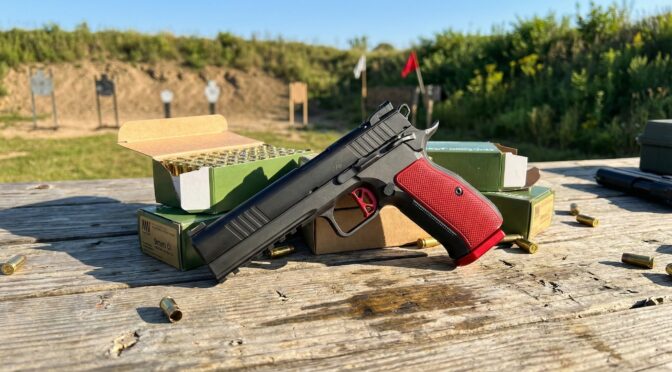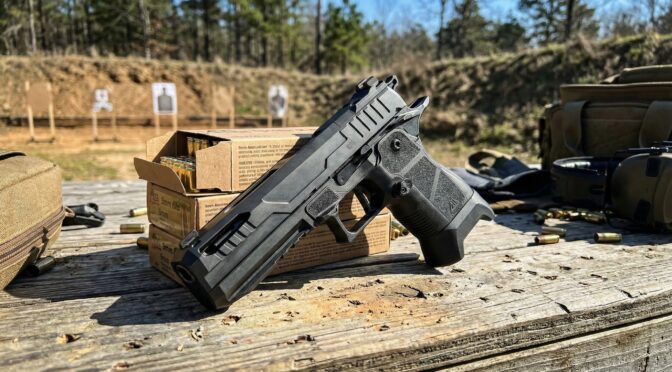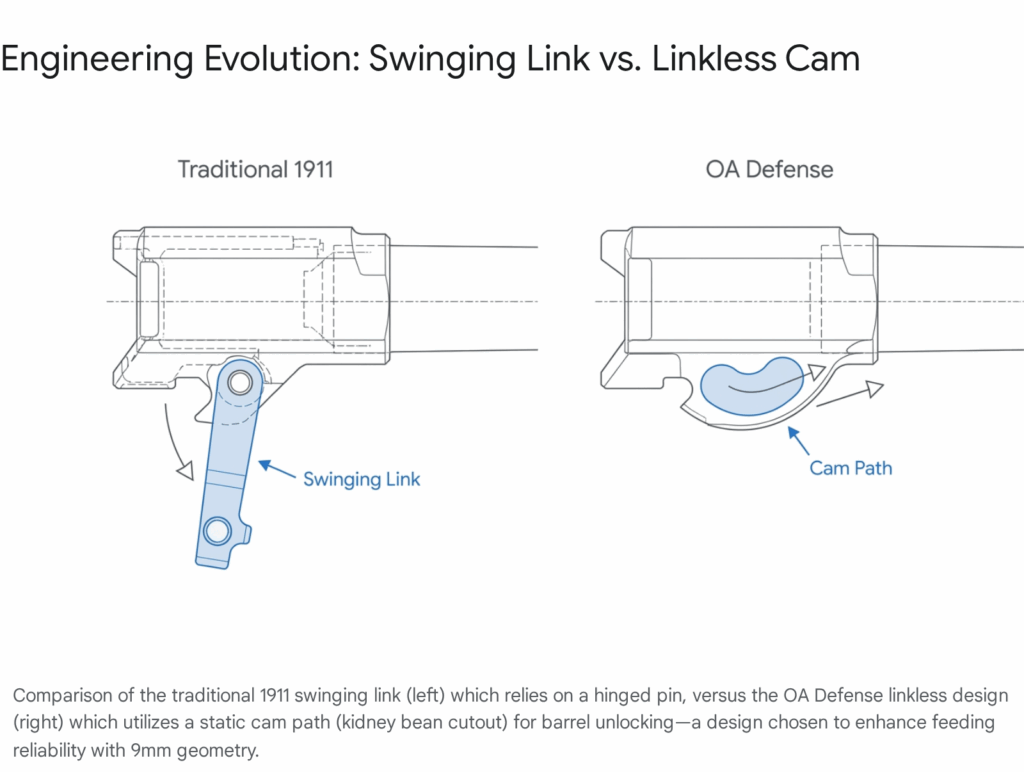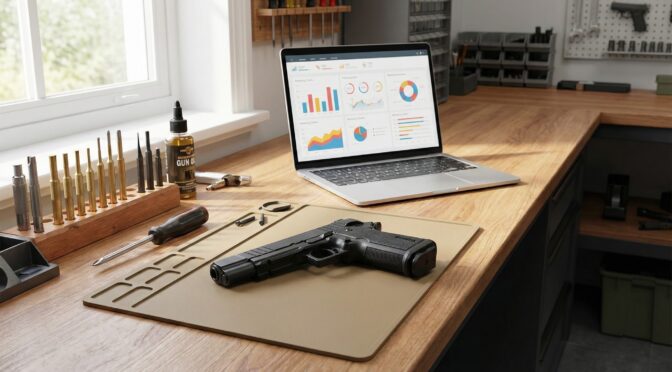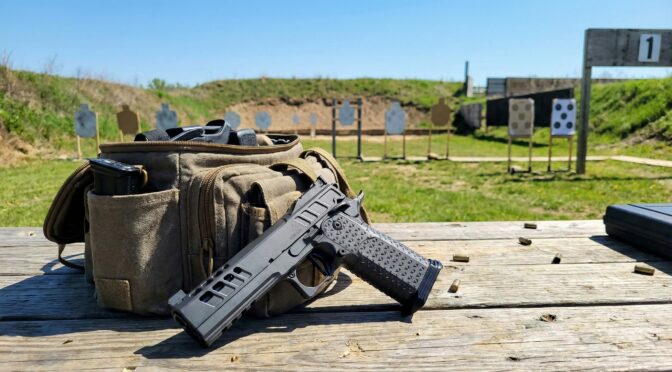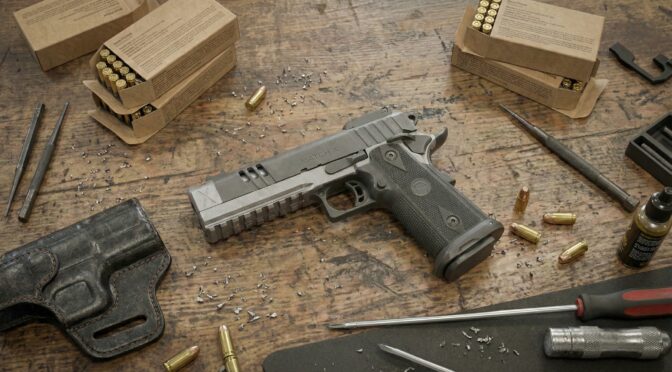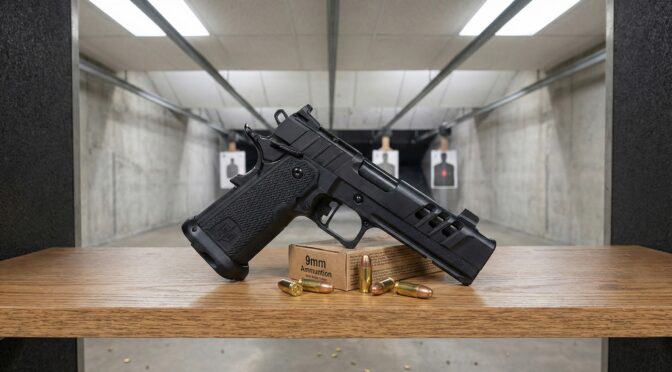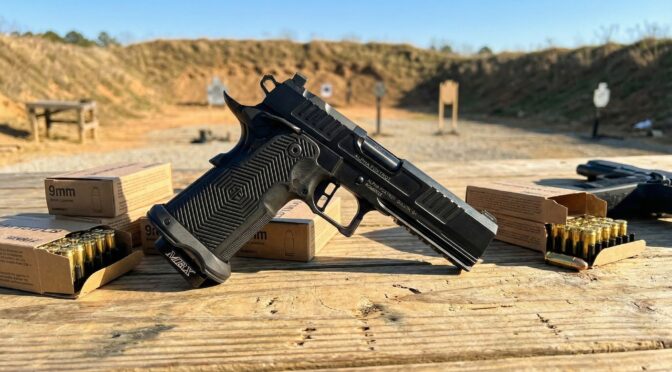The introduction of the Dan Wesson DWX into the premium semi-automatic pistol market marks a distinct inflection point in small arms design, representing a calculated hybridization of the two most dominant pistol architectures of the 20th century: the John Moses Browning 1911 and the Josef and František Koucký CZ 75. This report serves as a comprehensive industry analysis, engineering breakdown, and consumer sentiment review of the DWX platform. Engineered by Dan Wesson Firearms, a subsidiary of CZ-USA, the DWX was conceptualized to address specific logistical and mechanical inefficiencies inherent to the “2011” double-stack platform while simultaneously capitalizing on the ergonomic superiority of the CZ 75 airframe.
The primary value proposition of the DWX platform is its integration of the 1911’s unparalleled single-action fire control group with the high-capacity, reliable, and economically viable magazine ecosystem of the CZ P-09/P-10 series. This synthesis aims to deliver a “best of both worlds” solution for competitive shooters and discerning enthusiasts. Our analysis indicates that while the DWX successfully delivers mechanical accuracy and recoil management that rivals semi-custom pistols costing significantly more—such as the Staccato P—it currently faces challenges regarding manufacturing consistency, specifically concerning surface finish durability and small-part tolerances in post-2023 production batches. Despite these quality assurance headwinds, the platform remains a formidable market disruptor, particularly in the USPSA Limited Optics division, offering a distinctive alternative that undercuts traditional 2011 pricing while offering superior magazine logistics.
1. Introduction: Genesis of a Hybrid Architecture
To understand the engineering significance of the Dan Wesson DWX, one must first contextualize the market landscape it entered. For decades, the high-performance pistol market was bifurcated. On one side stood the 1911 and its double-stack evolution, the 2011, revered for its crisp, sliding-trigger pull and short reset but criticized for its reliance on tuned, expensive magazines and a complex disassembly process involving barrel bushings and swinging links. On the other side stood the CZ 75 and its derivatives (Shadow 2, TS), celebrated for their ergonomic “humpback” grip profile and reliability but limited by a hinged, double-action/single-action (DA/SA) trigger system that creates a longer reset and different take-up mechanics compared to the 1911.
The DWX project, initiated as a collaboration between Dan Wesson (noted for high-quality production 1911s) and CZ-USA, sought to bridge this schism. The objective was not merely cosmetic; it was a fundamental re-engineering effort to graft the 1911’s ignition system onto the CZ 75’s ergonomic geometry while modernizing the barrel lockup system to resemble the reliable, simplified camming of the polymer-framed CZ P-10 series.1 The result is a platform that feels like a CZ in the hand but shoots like a 1911, utilizing a modern locked-breech system that departs from the legacy designs of both parents. This report analyzes whether this ambitious engineering synthesis succeeds in practice and where it falters in execution.
2. Comprehensive Engineering Analysis
The DWX is a complex mechanical integration that selects specific advantages from distinct lineages while discarding their respective weaknesses. This section deconstructs the platform into its core subsystems.
2.1 Chassis Dynamics and Frame Geometry
The structural foundation of the DWX represents a radical departure from standard 1911 manufacturing protocols. Traditional 1911 architecture relies on a modular grip safety and a mainspring housing that are mechanically distinct from the frame’s primary load-bearing structure. In contrast, the DWX adopts the CZ 75’s contiguous grip profile, a design choice that has profound implications for recoil management and shooter interface.2
The grip angle and contour are derived directly from the CZ 75, utilizing the iconic “humpback” design. This geometry forces the shooter’s hand high into the beavertail, effectively lowering the bore axis relative to the shooter’s wrist. By reducing the vertical distance between the bore centerline and the fulcrum of the wrist, the DWX minimizes the leverage arm available for recoil forces to act upon, thereby converting a significant portion of muzzle flip into linear rearward impulse.5 This ergonomic advantage is a primary reason for the CZ 75’s dominance in production-class competition, and its inclusion here addresses a common criticism of the 2011’s blocky, slab-sided grip.
In terms of slide-to-frame interaction, the DWX reverses the traditional CZ 75 design ethos. While CZ pistols are famous for having the slide ride inside the frame rails—theoretically tightening lockup but reducing slide surface area for manipulation—the DWX slide rides outside the frame rails, mimicking the 1911.2 This engineering choice serves multiple purposes: it increases the available surface area on the slide for aggressive serrations, facilitates easier clearing of malfunctions, and allows Dan Wesson to utilize their established 1911 slide fitting techniques to ensure a tight, glass-smooth travel free of lateral play.
Material composition varies by model to suit specific use cases. The Full-Size DWX is constructed on a forged steel frame, contributing to a substantial unloaded weight of approximately 45 ounces.3 This mass acts as a passive recoil damper, soaking up kinetic energy and stabilizing the platform during rapid strings of fire. Conversely, the DWX Compact utilizes a 7075-aluminum alloy frame, reducing the total weight to a carry-friendly 28-30 ounces.1 The aluminum frame features an anodized finish, distinct from the DLC or nitride found on the steel variants, and presents different wear characteristics over the lifespan of the weapon.
2.2 Ignition System: The 1911 Fire Control Group
The fire control group (FCG) constitutes the primary “1911 DNA” within the DWX architecture. Despite the external appearance of a CZ, the internal hammer, sear, and disconnector assembly is fundamentally identical to the Series 70 1911 system.2 This is a critical distinction for the target demographic, as the 1911 trigger is the gold standard for precision shooting.
The trigger shoe itself is a flat-faced, K-style skeletonized component, aesthetically distinct but mechanically familiar.4 It utilizes a rigid trigger bow that translates linear finger pressure directly to the sear, bypassing the hinged pivot mechanics of the CZ 75 trigger. This allows for the tuning characteristics that 1911 gunsmiths prize: minimal pre-travel, a distinct “glass rod” wall, and a micro-reset. Factory pull weights are consistently measured between 3.5 and 4.5 lbs, with a clean break that often settles closer to 3.75 lbs after a 500-round break-in period.7
Crucially, the DWX omits the grip safety found on standard 1911s.2 In the competitive sphere, the grip safety is often viewed as a liability—a failure point that can prevent the gun from firing if the shooter achieves a less-than-perfect grip during a high-stress draw or while shooting from an awkward position. By removing this variable, Dan Wesson aligns the DWX with the preferences of USPSA and IDPA shooters who frequently pin or deactivate grip safeties on their 2011s. However, the retention of the ambidextrous manual thumb safety allows for “cocked and locked” (Condition One) carry, necessitating a manual of arms identical to the 1911.2 The safety levers are contoured similarly to extended 1911 controls, providing a familiar shelf for the shooter’s thumb to ride, further aiding in recoil control.
2.3 Barrel Kinematics: The Linkless Evolution
Perhaps the most significant engineering divergence from the 1911 lies in the barrel lockup and recoil system. The DWX abandons the traditional swinging link—a component that requires precise timing and can be a breakage point—in favor of a simplified, linkless cam system derived from the CZ P-10 and P-09.2
The barrel lockup utilizes a modified Browning-Petter system. Instead of radial locking lugs machined into the top of the barrel (as seen in 1911s and early CZ 75s), the DWX employs a squared breech block that locks directly into the ejection port.11 This “square breech” design simplifies manufacturing by eliminating complex machining operations on the barrel and slide interior, while simultaneously providing a robust, repeatable lockup that enhances accuracy. When the pistol is fired, the barrel and slide move rearward together until the angled cam surface on the barrel lug interacts with the slide stop pin, pulling the barrel downward and unlocking the breech.12
Furthermore, the DWX utilizes a bushing-less bull barrel system.1 In a standard 1911, a barrel bushing creates the interface between the barrel and slide at the muzzle. This requires hand-fitting to achieve accuracy. The DWX’s heavy bull barrel features a slight flare at the muzzle to lock directly against the slide. This adds non-reciprocating mass to the muzzle end, aiding in muzzle flip mitigation, and simplifies the field-stripping process to a sequence more akin to a modern striker-fired pistol than a traditional 1911.13 The removal of the bushing and recoil spring plug further streamlines the front end of the pistol.
2.4 Recoil Management Systems
The recoil impulse of the DWX is managed through a combination of mass and spring dynamics. The full-length dust cover, which features a seven-slot Picatinny rail, adds significant static weight to the front of the frame.3 This acts as a counterweight to muzzle rise. The recoil spring assembly utilizes a flat-wire spring on a full-length guide rod.14 Flat-wire springs are noted for their longer service life and consistent compression rates compared to standard round-wire springs.
The “P-10 style” takedown method, utilizing the slide stop as the locking key, is integral to this system.1 This design allows for easier maintenance compared to the 2011, which often requires a paperclip or specialized tool to capture the recoil spring for removal. The DWX system allows the user to align the takedown notches and remove the slide stop, allowing the entire upper assembly to slide off the frame—a familiar process for any CZ owner.
2.5 The Magazine Ecosystem: Logistics as a Feature
One of the most strategic engineering decisions in the DWX’s development was the rejection of the 2011 “STI/Staccato” magazine pattern. Traditional 2011 magazines were originally designed for the longer.38 Super cartridge and subsequently adapted for 9mm. This legacy geometry often resulted in reliability issues, requiring users to tune feed lips and followers to prevent nose-diving rounds. Furthermore, these proprietary magazines are prohibitively expensive, often retailing between $70 and $100 per unit.15
The DWX solves this logistical hurdle by utilizing the magazine body of the CZ P-09 and P-10 F.1 These magazines were designed from the ground up for the 9x19mm cartridge in a double-stack configuration, featuring a tapered geometry that inherently enhances feeding reliability. They are widely available, mass-produced, and retail for approximately $30-$35.16 This decision drastically lowers the cost of ownership and ensures that competitors can easily acquire reliable magazines without resorting to expensive tuning or aftermarket components. The compatibility extends to base pads and extensions, allowing users to leverage the existing ecosystem of Henning and other aftermarket support for the P-10 series.16
3. Performance Analysis
The theoretical advantages of the DWX’s hybrid design must be validated by performance metrics. This section evaluates the platform based on aggregated data regarding mechanical accuracy, recoil impulse, and operational reliability.
3.1 Mechanical Accuracy Protocols
The fixed barrel lockup mechanism, combined with the tight slide-to-frame tolerances characteristic of Dan Wesson’s manufacturing, results in exceptional mechanical accuracy that punches well above the platform’s price point. Independent bench rest testing indicates that the full-size DWX is capable of producing 5-shot groups ranging from 1.0 to 1.5 inches at 25 yards when using match-grade ammunition such as Hornady HAP or Federal Gold Medal Match.6
In more rigorous controlled testing using a Ransom Rest—which eliminates shooter error—tuned examples of the DWX have demonstrated the capability to produce sub-0.5 inch groups at 25 yards.17 This level of precision is comparable to custom-built 2011s that cost nearly twice as much. The “match grade” barrel marketing appears to be substantiated by these results, validating the efficacy of the bushing-less, squared-breech lockup system.
The Compact model, while mechanically capable of similar precision, presents more practical challenges due to its shorter sight radius and lighter weight. Testing suggests that while the mechanical accuracy remains high, practical group sizes average between 1.8 and 2.0 inches at 25 yards with defensive ammunition.6 This is still well within the requirements for a concealed carry or defensive firearm.
3.2 Recoil Impulse and Shootability
The recoil character of the DWX varies significantly between the Full-Size and Compact variants due to the disparity in frame mass.
Full Size DWX: The 45-ounce steel frame, combined with the camming action of the barrel, creates a recoil impulse often described as “sluggish” but incredibly flat. The heavy static weight of the frame and dust cover resists the torque of the recoil, preventing the muzzle from snapping upward. The slide velocity is tuned for competition, ensuring that the sights return to zero predictably and quickly. When compared to the Staccato P (steel frame), many shooters report that the DWX shoots flatter, attributed to the distinct balance point created by the full-length dust cover and the ergonomic high-grip capability of the CZ frame.18
DWX Compact: The transition to an aluminum frame drastically alters the physics of the weapon. Weighing approximately 28-30 ounces, the Compact lacks the mass to dampen the recoil energy to the same degree. Consequently, the recoil impulse is described as “snappier” and sharper than the Full Size.20 While the ergonomic frame allows for a high grip to control this energy, the laws of physics dictate higher slide velocity and more muzzle rise. Users transitioning from the steel version to the aluminum Compact should anticipate a distinct difference in handling characteristics, requiring a firmer grip to manage the faster cycle rate.
3.3 Reliability and Endurance Profile
Reliability is the paramount metric for any defensive or competitive firearm. The DWX’s feed geometry plays a crucial role here. The ramped barrel design, combined with the proven P-series magazines, provides a straight-line feed path that is highly tolerant of various bullet ogives. The platform reliably feeds hollow points, flat-nosed competition loads, and standard ball ammunition.6
A critical reliability enhancement is the use of a massive external extractor, similar to the P-10 design. This addresses the primary weakness of the traditional 1911: the internal extractor, which relies on precise tensioning and can lose tension over time, leading to extraction failures. The DWX’s external extractor is coil-spring driven, providing consistent, robust extraction force that is not dependent on the subtle bending of a steel bar.10
However, the tight tolerances of the rail system necessitate a break-in period. Dan Wesson officially recommends a break-in of 300-500 rounds. During this initial phase, the slide-to-frame fit may be tight enough to cause sluggish return-to-battery malfunctions if the firearm is not sufficiently lubricated.23 This is a characteristic feature of high-performance, tight-tolerance pistols and should be anticipated by the user. Once broken in, the system is reported to run with high reliability.
3.4 Operational Data Table
The following table synthesizes performance metrics across the two primary variants:
| Metric | DWX Full Size | DWX Compact |
| Typical 25y Group (Bench) | 1.0″ – 1.5″ | 1.8″ – 2.0″ |
| Recoil Impulse | Flat, Soft, Heavy Damping | Snappy, Fast, Sharp |
| Feed Reliability | High (P-10 Mags) | High (P-10 C Mags) |
| Break-in Requirement | 300-500 Rounds | 300-500 Rounds |
| Preferred Ammo | 124gr / 147gr Competition | 115gr / 124gr Defensive |
4. Consumer Sentiment and Quality Assurance
While the design architecture of the DWX is widely lauded, the execution in recent production runs—particularly throughout 2024 and 2025—has generated significant negative sentiment regarding quality assurance (QA) and material finish. This “long-tail” analysis of owner feedback reveals issues that often escape initial media reviews.
4.1 The “Coating-Gate” Controversy
The most significant detractor from the DWX’s reputation is the degradation of the surface finish on recent production units. Early marketing and technical specifications promised a DLC (Diamond-Like Carbon) finish, a coating renowned for its extreme hardness, low friction coefficient, and wear resistance. However, a significant volume of consumer reports and photographic evidence indicates that units produced in late 2024 and 2025 exhibit premature finish wear.25
Users have reported the finish wearing down to bare metal on high-contact areas—such as the barrel hood and slide rails—after fewer than 200 rounds. In some instances, holster wear has appeared after only a handful of draw strokes. This rapid degradation is uncharacteristic of true DLC and has led to widespread speculation that Dan Wesson quietly switched to a lower-grade “Duty Coat” or oxide finish while maintaining the price point of a premium DLC pistol. This perceived “downgrade” is a primary source of dissatisfaction for buyers who expect a $2,000 firearm to retain its aesthetic and protective qualities under normal use.27 The company’s response, often characterizing this rapid wear as “normal,” has further inflamed consumer sentiment.
4.2 Small Parts Tolerances: Sights and Safeties
Beyond the finish, recurring mechanical issues have been identified regarding small parts fitment. A frequent failure point reported by users involves the front sight. The dovetail cuts on some slides appear to be machined out of tolerance (too large) or the sights fitted are undersized. This results in the front sight drifting under recoil or, in severe cases, falling off entirely within the first 500 rounds.28 This suggests a lapse in dimensional quality control at the Norwich facility.
Additionally, reports of stiff or interfering safety levers on the Compact model have surfaced. Some users find the safety difficult to disengage or note that the lever geometry interferes with a high grip, necessitating aftermarket tuning or replacement with lower-profile levers.22
4.3 Supply Chain and Customer Support
Sentiment regarding Dan Wesson/CZ-USA customer service is mixed to negative. The integration of Dan Wesson support into the broader CZ-USA infrastructure appears to have created bottlenecks. Users reporting finish issues have frequently been told that rapid wear is within spec, leading to frustration. Those who do successfully initiate warranty claims often face turnaround times of 4-8 weeks for refinishing or repair.29 This service experience contrasts poorly with the “concierge” level support often provided by competitors in the 2011 space, such as Staccato or smaller custom shops.
5. Market Positioning and Comparative Analysis
The DWX occupies a unique “disruptor” position in the market, bridging the gap between mass-production competition guns and semi-custom 2011s. It challenges the established hierarchy by offering 2011-level performance at a significantly lower entry price, primarily by leveraging the economies of scale of the CZ magazine ecosystem.
5.1 The “2011” Economy: Price-to-Performance
The 2011 market is traditionally defined by high entry costs—not just for the pistol, but for the requisite accessories. A Staccato P retails for approximately $2,500, with magazines costing upwards of $75 each. A basic loadout of six magazines adds nearly $450 to the initial purchase.
In contrast, the DWX retails for approximately $2,000-$2,100.30 However, the true economic advantage lies in the magazines. CZ P-10 F magazines retail for approximately $30-$35. A six-magazine loadout costs roughly $200. This represents a significant long-term savings for high-volume shooters. Furthermore, the DWX’s steel frame offers a material advantage over the polymer grip module of the 2011 for those seeking maximum weight for recoil mitigation.
5.2 Competitor Deep Dive: Staccato P
The Staccato P is the primary benchmark against which the DWX is judged.
- Staccato Advantage: The Staccato P has a proven track record in law enforcement duty use, backed by rigorous testing and adoption by hundreds of agencies. It has an established ecosystem of duty holsters (Safariland 6360/6390 series) that fit without modification. Its resale value is exceptionally high.
- DWX Advantage: The DWX offers superior ergonomics for smaller hands due to the absence of the thick, blocky polymer grip module required by the 2011 design. The CZ grip profile is more contoured and accessible. The trigger pull on the DWX is often crisper out of the box compared to the duty-tuned trigger of the Staccato P.15
- Verdict: The Staccato wins on duty pedigree and holster support; the DWX wins on pure shootability-per-dollar and magazine logistics.18
5.3 Competitor Deep Dive: CZ Shadow 2
The CZ Shadow 2 dominates the USPSA Carry Optics and Production divisions.
- Shadow 2 Advantage: Significantly cheaper (MSRP ~$1,300), DA/SA trigger allows for second-strike capability and legality in Production division.
- DWX Advantage: The DWX is essentially a single-action Shadow 2. For shooters who prefer the consistent, short-travel trigger press of a 1911 but want the weight and balance of a Shadow 2, the DWX is the superior platform. It eliminates the double-action first pull, which is a significant training hurdle for many shooters.34
5.4 Comparative Matrix
| Feature | Dan Wesson DWX (Full Size) | Staccato P (Steel) | CZ Shadow 2 (OR) |
| Approx. Street Price | ~$2,000 | ~$2,500 | ~$1,100 – $1,300 |
| Action Type | SAO (1911) | SAO (2011) | DA/SA |
| Frame Material | Forged Steel | Steel Frame / Polymer Grip | Steel |
| Unloaded Weight | ~45 oz | ~38 oz | ~46.5 oz |
| Magazine Cost | ~$35 (CZ P-10) | ~$75 – $100 | ~$35 |
| Holster Support | Limited / Custom | Extensive / Duty Rated | Extensive / Competition |
| Optic Ready | Specific Models Only | Standard (DPO) | Yes (OR Models) |
| Duty Suitability | Low | High | Low |
6. Operational Use Case Assessment
Based on the engineering attributes and performance data, we can define the optimal operational envelope for the DWX.
6.1 Competitive Shooting (High Suitability)
The DWX is purpose-built for the competition circuit.
- USPSA Limited Optics: This is the natural home for the Full-Size DWX. The division allows for SAO triggers, magwells, and slide-ride optics. The DWX’s weight dampens recoil, and the 1911 trigger allows for splits (time between shots) that rival any platform on the market. With simple base pad extensions, the P-10 magazines can easily reach the 140mm length limit for maximum capacity (23+1 rounds).
- 3-Gun: The high capacity, reliability, and flat shooting characteristics make it an excellent choice for multigun competitions where long-range pistol shots on steel are required. The mechanical accuracy is a significant asset here.
- IDPA: The Full Size is generally too heavy for IDPA (max 43 oz) without significant lightening cuts. However, the Compact fits comfortably within the Enhanced Service Pistol (ESP) or Carry Optics (CO) weight limits, offering a “cheater gun” level of performance in a compact package.34
6.2 Duty / Tactical Use (Low Suitability)
Despite its performance, the DWX is not currently recommended as a primary duty weapon for law enforcement or military application.
- Holster Ecosystem: There is a critical lack of factory-supported Level 3 retention holsters. While users have successfully modified Staccato P or M&P Safariland 6390RDS holsters to fit the DWX 35, this typically involves heating and reshaping the kydex or modifying the internal barrel plug. Agency policy rarely permits modified retention equipment.
- Tolerance Sensitivity: The tight rail tolerances that aid accuracy also make the platform more susceptible to debris-induced malfunctions compared to loose-tolerance duty guns like Glocks. It is a precision instrument, not a blunt force tool.
- Safety Policy: The lack of a grip safety is a policy violation for many agencies that mandate redundant passive safeties.
6.3 Concealed Carry (Moderate Suitability – Compact Only)
- DWX Compact: With its aluminum frame, the Compact is viable for concealed carry. However, the manual of arms (cocked and locked) requires dedicated training. The wide, extended safety levers—excellent for competition—can be an impediment to deep concealment, printing through clothing or accidentally disengaging. Users carrying the DWX Compact often swap these for lower-profile safety levers. The lack of a firing pin block (Series 70 style) is a consideration for some, though the heavy firing pin spring and light titanium firing pin (if equipped/upgraded) generally mitigate drop risks.
7. Conclusion
The Dan Wesson DWX is a triumph of hybrid engineering that successfully resolves the magazine cost and reliability issues of the 2011 platform while preserving the premiere shooting characteristics of the 1911 trigger and the ergonomic excellence of the CZ 75. It represents a “best buy” in the high-performance steel-frame market, offering a mechanical accuracy and recoil control profile that outperforms semi-custom pistols costing 30% more.
However, the value proposition is currently compromised by inconsistent manufacturing execution. The “Coating-Gate” controversy and small-parts tolerance issues indicate that Dan Wesson is struggling to maintain QC consistency at scale. The prospective buyer must view the DWX as an “enthusiast’s platform”—one that delivers exceptional raw performance but may require minor aftermarket support (sight replacement, potential refinishing) to reach its full potential.
Final Verdict:
- Buy: If you are a competitive shooter (USPSA Limited Optics/3-Gun), a 1911/CZ enthusiast, or a shooter seeking the highest performance-to-price ratio in the double-stack market and are willing to navigate potential finish wear or minor fitting issues.
- Pass: If you require a strictly duty-rated weapon with an established Level 3 holster ecosystem, or if the prospect of cosmetic wear on a new premium firearm is unacceptable to you.
Appendix A: Methodology
This report was synthesized using a multi-source intelligence gathering approach, designed to triangulate technical truth from manufacturer claims, independent testing, and end-user feedback.
- Technical Specification Analysis: We established baseline engineering data (materials, dimensions, mechanical operations) using official documentation from Dan Wesson/CZ-USA.1 This was cross-referenced with exploded diagrams and parts lists 14 to confirm component interchangeability (e.g., 1911 trigger parts vs. proprietary external extractor).
- Performance Data Aggregation: Objective performance metrics were extracted from third-party reviews by reputable firearms publications (Guns & Ammo, Handguns Mag, American Rifleman).2 Data points such as bench-rest group sizes, velocity consistency, and trigger pull weight measurements were aggregated to form a performance baseline.
- Sentiment and QC Analysis: A qualitative analysis of “long-tail” user feedback was conducted across high-traffic discussion platforms (Reddit r/DWX, r/2011, Dan Wesson Forum). This phase was critical for identifying recurring quality control issues (coating degradation, sight drift) that typically do not appear in initial press reviews or marketing materials.25
- Comparative Heuristics: The DWX was evaluated against its primary market competitors (Staccato P, CZ Shadow 2) using a features-to-cost heuristic. This involved comparing not just the unit cost, but the “total cost of ownership” including magazines and accessories, to determine relative market value.15
If you find this post useful, please share the link on Facebook, with your friends, etc. Your support is much appreciated and if you have any feedback, please email me at in**@*********ps.com. Please note that for links to other websites, we are only paid if there is an affiliate program such as Avantlink, Impact, Amazon and eBay and only if you purchase something. If you’d like to directly contribute towards our continued reporting, please visit our funding page.
Sources Used
- DWX Compact With Light Rail – Dan Wesson Firearms, accessed December 9, 2025, https://danwessonfirearms.com/product/dwx-compact-with-light-rail/
- Dan Wesson DWX: Full Review – Guns and Ammo, accessed December 9, 2025, https://www.gunsandammo.com/editorial/dan-wesson-dwx-full-review/481815
- Dan Wesson DWX Blends 1911, CZ Pistols for Wild Hybrid Design – Athlon Outdoors, accessed December 9, 2025, https://athlonoutdoors.com/article/dan-wesson-dwx-1911-cz/
- WATCH: Dan Wesson DWX Pistol | An NRA Shooting Sports Journal, accessed December 9, 2025, https://www.ssusa.org/content/watch-dan-wesson-dwx-pistol/
- Dan Wesson DWX – American Handgunner, accessed December 9, 2025, https://americanhandgunner.com/discover/dan-wesson-dwx/
- Dan Wesson’s DWX 9mm – The Lipsey’s Bulletin, accessed December 9, 2025, https://www.lipseysbulletin.com/firearms/dan-wessons-dwx-9mm/
- Dan Wesson DWX Compact 9mm Pistol: Review – Handguns, accessed December 9, 2025, https://www.handgunsmag.com/editorial/dan-wesson-dwx/453791
- TFB Review: Dan Wesson DWX 2011 | thefirearmblog.com, accessed December 9, 2025, https://www.thefirearmblog.com/blog/2023/01/11/tfb-review-dan-wesson-dwx-2011/
- Dan Wesson DWX, the handgun evolved – RangeHot – Expert …, accessed December 9, 2025, https://rangehot.com/dan-wesson-dwx-the-handgun-evolved/
- The Dan Wesson DWX, Tested and Reviewed – Outdoor Life, accessed December 9, 2025, https://www.outdoorlife.com/guns/dan-wesson-dwx-review/
- Dan Wesson DWX: The Best Of Two Worlds? [Hands-on Review] – Recoil Magazine, accessed December 9, 2025, https://www.recoilweb.com/dan-wesson-dwx-the-best-of-two-worlds-hands-on-review-177850.html
- Review: Dan Wesson DWX | An Official Journal Of The NRA – American Rifleman, accessed December 9, 2025, https://www.americanrifleman.org/content/review-dan-wesson-dwx/
- DWX Optics Ready 9MM – Dan Wesson Firearms, accessed December 9, 2025, https://danwessonfirearms.com/product/dwx-optics-ready-9mm/
- SPARE PARTS – DWX – Dan Wesson Products | CZ-USA, accessed December 9, 2025, https://shop.cz-usa.com/dw-products/dwx/spare-parts.html
- CZ Shadow 2 OR (CGW Pro Package) vs. Staccato P. (bone stock)…. Which one do you pick any why? – Reddit, accessed December 9, 2025, https://www.reddit.com/r/handguns/comments/1bq98qq/cz_shadow_2_or_cgw_pro_package_vs_staccato_p_bone/
- Shop Dan Wesson Parts, accessed December 9, 2025, https://benstoegerproshop.com/gun-parts/dan-wesson/
- DAN WESSON DWX PERFORMANCE PACKAGE©, accessed December 9, 2025, https://irp.cdn-website.com/98474a0c/files/uploaded/DAN_WESSON_DWX_2026.pdf
- Staccato P vs XL – vs Dan Wesson DWX : r/2011 – Reddit, accessed December 9, 2025, https://www.reddit.com/r/2011/comments/1dj2ta4/staccato_p_vs_xl_vs_dan_wesson_dwx/
- DWX Vs. Staccato P? – Reddit, accessed December 9, 2025, https://www.reddit.com/r/DWX/comments/15t0uew/dwx_vs_staccato_p/
- Would the compact DWX have more recoil than the full size? – Reddit, accessed December 9, 2025, https://www.reddit.com/r/DWX/comments/1bfv6bq/would_the_compact_dwx_have_more_recoil_than_the/
- Staccato C full size vs DWX COMPACT THE BATTLE OF THE COMPS WHICH ARE YOU TAKING?? – Reddit, accessed December 9, 2025, https://www.reddit.com/r/2011/comments/1fw2h7o/staccato_c_full_size_vs_dwx_compact_the_battle_of/
- DWX compact issues (shell extraction and slide not advancing all the way forward) – Dan Wesson Forum, accessed December 9, 2025, https://www.danwessonforum.com/forum/general-messages/dwx-compact-issues-shell-extraction-and-slide-not-advancing-all-the-way-forward/
- Instruction Manual – Dan Wesson Firearms, accessed December 9, 2025, https://danwessonfirearms.com/wp-content/uploads/2023/01/DWX-Manual.pdf
- New DWX Issues – Reddit, accessed December 9, 2025, https://www.reddit.com/r/DWX/comments/1bveruw/new_dwx_issues/
- DWX Coating/Finish Issues Megathread – Reddit, accessed December 9, 2025, https://www.reddit.com/r/DWX/comments/1luucis/dwx_coatingfinish_issues_megathread/
- DWX coating wear – Reddit, accessed December 9, 2025, https://www.reddit.com/r/DWX/comments/1ld9iug/dwx_coating_wear/
- 200 round wear? : r/DWX – Reddit, accessed December 9, 2025, https://www.reddit.com/r/DWX/comments/1mbzg1p/200_round_wear/
- DWX still having front sight issues – Reddit, accessed December 9, 2025, https://www.reddit.com/r/DWX/comments/1gpbloc/dwx_still_having_front_sight_issues/
- DWXc – Warranty Refinish : r/DWX – Reddit, accessed December 9, 2025, https://www.reddit.com/r/DWX/comments/1oofsbm/dwxc_warranty_refinish/
- Buy dan wesson dwx Online at GunBroker.com, accessed December 9, 2025, https://www.gunbroker.com/pistols/search?keywords=dan+wesson+dwx
- dan-wesson dwx-compact For Sale – GunBroker.com, accessed December 9, 2025, https://www.gunbroker.com/pistols/search?keywords=dan-wesson+dwx-compact
- 500 rounds with Staccato P, CZ Shadow 2 (SAO) and Dan Wesson DWX – YouTube, accessed December 9, 2025, https://www.youtube.com/watch?v=AXF7PJOWizs
- Staccato P vs DWX: Your SHTF Sidearm Pick? : r/2011 – Reddit, accessed December 9, 2025, https://www.reddit.com/r/2011/comments/1kq0fpb/staccato_p_vs_dwx_your_shtf_sidearm_pick/
- Shadow 2 or DWX? – Reddit, accessed December 9, 2025, https://www.reddit.com/r/DWX/comments/1h34ufg/shadow_2_or_dwx/
- Safariland 6390RDS ALS Red Dot Mid-Ride Duty Holster – Operationally Proven Tactical, accessed December 9, 2025, https://www.optactical.com/product/safariland-6390rds-als-red-dot-mid-ride-duty-holster/
- 6390RDSO – ALS® MID-RIDE DUTY RATED LEVEL I RETENTION™ HOLSTER | Safariland, accessed December 9, 2025, https://safariland.com/products/6390rdso-als-mid-ride-level-i-retention-duty-holster
- Spare Parts – 1911 – Dan Wesson Products | CZ-USA, accessed December 9, 2025, https://shop.cz-usa.com/dw-products/1911/spare-parts.html?p=2
- Finish coming off DWX after a month – Reddit, accessed December 9, 2025, https://www.reddit.com/r/DWX/comments/1hzdp9t/finish_coming_off_dwx_after_a_month/
